Hi-Fi '97 Show Report - June, 1997
Staff
![]()
Once again the Hi-Fi show is upon us. This year, Hi-Fi '97 was presented at the Westin St. Francis Hotel in San Francisco, May 28 - June 1. There did not seem to be as many exhibitors as last year's show in New York. During the Trade days the air conditioning system in the hotel did not even seem to work, and the heat was bad. I was told that it is usually cold at this time in the city, but it was 80+ degrees every day I was there. Besides the temperature, there were some hot products at the show. The best video was in the Meridian suite (IMHO).
One of my favorite parts of the show is the sales floor; this is where you get companies like Chesky, Reference Recordings, Audio Advisor and others selling their products. The prices are usually lower and there was no sales tax.
The following are the rooms I visited that stood out to me:
Camelot Technologies
Howard Schilling was showing off his latest transport, the Merlin, hooked up to the Uther. The sound was being presented by Total Media Systems speaker package. They utilized the Left and Right and sub combo, not the full theater package. Michael Levy was on hand explaining every detail of his speaker system. One of the new products that I am excited about is their (Camelot) powered S-Video cable, the Excalibur. This little box is said to allow you to run up to 150 feet with no video signal loss. It has a 1 meter S-Video lead on the end. You plug your standard S-Video cable in-between this box and your TV. I hope to have one as soon as it is available, and I will report on its performance then.
Camelot has also announced that they will be the "official" distributor for the Crystal Vision VPS-1 Video Processing system. This is a 2D-Adaptive Digital comb filter from the team who brought you the Audio Alchemy VRE, Peter Madnick and Neil Woodall. Apparently, it has 50% more horsepower than the VRE. They are hoping to have this new unit out around September.
Citation
While no demonstration was being given, they had a booth set up with their new 5.0 AV Controller. This is their new processor that has 6-Axis, Dolby Digital, and an optional DTS card. The suggested retail price for this with DTS is $3,500. Their 7.5 Dolby Digital processor has been scrapped in favor of a replacement processor to the 7.0. They will be announcing this new product at a later date and are planning a trade-in program for all 7.0 owners.
DCS
DCS has introduced their Elgar 24 Bit/96 kHz DAC, for a mere $12k. This room had some of the most exciting sounds at the show. They played the new Stereophile Gershwin disc, followed by the 24 Bit/96 kHz version from the master on the Nagra tape. WOW! I hate to report on something that does not exist commercially yet, but, WOW! If this is any indication of the near future for high-end audio, then I am looking forward to it. Chesky has mastered some of their new CDs in this format and then down-converted them to 16 Bit/44.1 kHz. When 24/96 becomes a reality, I am sure they will re-release favorites in the new format by simply going back to the master tape. I picked up Sarah K's 'Hobo' and it sounds very good, even in the down-converted version.
Faroudja
Faroudja introduced their new Video/PC Processor called the Presentation Plus. This new device allows high quality video images to be displayed on your PC without degradation, except for your bank account ($30,000). The demo was being given in a room shared with Cello and Vidikron. The video in this room was very good. Faroudja also showed their new DVD player priced at $5,495. The audio, which was being processed by the Theta Casablanca, was also excellent.
Faroudja was also set up in another room shared again with Vidikron and Mcintosh. The video in this room, each time I was there, was mediocre. The detail setting on the Faroudja VP-400A was always cranked up, creating an etched-like picture. It was just used improperly, because I have seen both the VP-400A and Vidikron "Vision Two" look fantastic.
Home Cinema Accessories
While this company does not actually make audio or video products, they do offer the finishing touches for home theater. They have theater seating, popcorn machines, illuminated poster cases, posters, red velvet ropes (to hang yourself when you get the bill), and anything else you can think of that "real" movie theaters use. I have always wanted some illuminated poster cases, and can't wait to get a couple (anyone have a Marisa Tomei poster they want to sell?)
Lexicon
Great news for all of the Lexicon DC-1 owners: they will be offering a DTS upgrade, at an MSRP of $495.00. Somewhere around September of this year.
Marantz
Marantz demo'd their new Dolby Digital receiver, the 60" R/P TV, and their DVD player. Although the picture on the TV was very good, the player and TV lack component video connections. The TV will come from the factory calibrated at 6500 Kelvins and will be converged by a computer system, to give you a clean looking picture! The MSRP for the 60" PV-6070 is $4,500. They will also have a 54" PV-5470 for $3,800.
Meridian
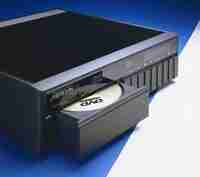 Without a doubt, the BEST video at the show could be found in their room.
They were showing off their new 586 DVD player. This was feeding the Snell & Wilcox Interpolator
1, and the Vidikron "Vision Two" projector. People are always talking
about the future, such as HDTV, when they have not even seen the best of present (NTSC).
The image in this exhibit rivaled that of 35mm film! Bob Stuart was gracious enough to let
me view the new ".9" version of Video Essentials. I first looked
at the Snell & Wilcox Zone Plate pattern. This was the same pattern we used at the
Florida videophile show. None of the problems that we had seen with other DVD players were
evident with the 586. Like the Faroudja, the Meridian 586 starts out as a
Toshiba DVD player (Which is quite good to begin with), and then they perform
surgery. Meridian, being a pioneer in digital audio, has gone to great lengths to ensure
that the 586 does the audio as well as it does the video. They have done as much as
possible to ensure that jitter problems are eliminated. Various clips were shown from
"Goldeneye", "Eric Clapton", and the DTS DVD sampler, which included
"Waterworld".
Without a doubt, the BEST video at the show could be found in their room.
They were showing off their new 586 DVD player. This was feeding the Snell & Wilcox Interpolator
1, and the Vidikron "Vision Two" projector. People are always talking
about the future, such as HDTV, when they have not even seen the best of present (NTSC).
The image in this exhibit rivaled that of 35mm film! Bob Stuart was gracious enough to let
me view the new ".9" version of Video Essentials. I first looked
at the Snell & Wilcox Zone Plate pattern. This was the same pattern we used at the
Florida videophile show. None of the problems that we had seen with other DVD players were
evident with the 586. Like the Faroudja, the Meridian 586 starts out as a
Toshiba DVD player (Which is quite good to begin with), and then they perform
surgery. Meridian, being a pioneer in digital audio, has gone to great lengths to ensure
that the 586 does the audio as well as it does the video. They have done as much as
possible to ensure that jitter problems are eliminated. Various clips were shown from
"Goldeneye", "Eric Clapton", and the DTS DVD sampler, which included
"Waterworld".
In their other room, Meridian was showing off their new Reference 800 series, which
consists of the 800 CD Machine and 861 Surround Sound Processor. This
was feeding three Meridian DSP 6000 digital loudspeakers. I am familiar with the DSP
6000s and the 565 Surround Sound Processor, but the 861/800 combo
was jaw dropping! Holly Cole and Rebecca Pigeon never sounded so good on CD. One reason
for this was the almost total elimination of jitter. Meridian uses a RAM buffer to clean
up the data. The data are read from a CD-ROM drive and then fed into the buffer. Then, the
DACs receive the data from the buffer at a constant speed.
Monster Cable
 Here is a company, who at every show, has something new to
introduce. Along with a new line of cables, they have announced a partnership with the Entec
design team, including Peter Madnick (Audio Alchemy Fame), Demian Martin,
and Noel Lee. The products they will be offering include 2 high quality D/A
converters, an automated A/V distribution amplifier, and a broadcast quality cascadable
A/V switcher. Their new line of cables is called the Z Series. This includes the Z3
Reference, Z2 biwire, Z2 Reference, and the Z1. They also have their new
Sigma Retro series and new Monster Network Terminator. This new network can
be found in their M2.2 and M2.4 Biwire speaker cables.
Here is a company, who at every show, has something new to
introduce. Along with a new line of cables, they have announced a partnership with the Entec
design team, including Peter Madnick (Audio Alchemy Fame), Demian Martin,
and Noel Lee. The products they will be offering include 2 high quality D/A
converters, an automated A/V distribution amplifier, and a broadcast quality cascadable
A/V switcher. Their new line of cables is called the Z Series. This includes the Z3
Reference, Z2 biwire, Z2 Reference, and the Z1. They also have their new
Sigma Retro series and new Monster Network Terminator. This new network can
be found in their M2.2 and M2.4 Biwire speaker cables. 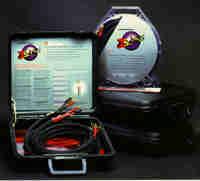
Theta
This exhibit used Runco for its projection system and Martin Logan for the speaker system. Their Casablanca provided processing for DTS. DVD players included the Meridian 586 and Sony DVP-S7000. They were showing off the quality of DTS in their main room with video, while the audio only system was next door. Theta will have both the Circle Surround matrix decoding and Spatializer cards available soon.
THX
*** NOTE *** THX has found that someone in China is making black market copies of their famous "WOW" disc. These copies have washed out colors, are about 6 dB down from reference level, and have no chapter stops. Beware if you are trying to purchase one of these off the many auctions on the Internet.
Toshiba
Here is a company that deserves a big pat on the back! Not only was Toshiba the first to offer component outputs on their DVD player, they also offer component inputs on their new 16:9 TVs. For 1997, Toshiba will be releasing ten new TVs with "Color Stream Component Inputs", their fancy new name for component video. The line includes one 36" direct view, and nine Rear Projection (R/P) TVs. One of those R/P TVs is their new 65" 16:9.
Toshiba is also trying something else this year; they are offering three TVs with progressive scan technology. In the past, these TVs have been called IDTV, and have never been implemented well. But time has passed, and lots has been learned, so this could be a huge step in the right direction. They did not have any of these sets on display, so I am unable to tell you how much improvement there is. They are supposed to hit stores in August. The TW65G80 has a suggested retail price of $7,299.95, their new 71" (their biggest TV to date) the TP71G90 is also $7,299.95, and, lastly, their 61" TP61G90 has a suggested retail of $4,099.95. Toshiba is the first consumer manufacturer to offer a wide selection of component video input TVs. I hope others will follow their example quickly.
*** NOTE *** For those of you who have purchased the Toshiba
SD-3006 DVD player, make sure you send in your registration card. Once Joe Kane's Video
Essentials is released, you will be sent a copy of it. There is no information in the
box about this promotion. You will only receive the disc if you mail in your registration
card!!! Like Sony, Toshiba is also using 10-Bit Video DACs in their DVD players. 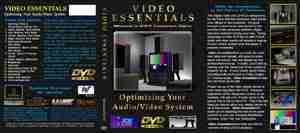
Toshiba does Dolby Digital. Their first entry-level receiver is the XB-1507, with a suggested retail price of $999.00, and they also have their flagship XB-2000 for $1,899.00.
Zenith
Zenith was showing off their PRO 900 projector with their new DVD player. They had two rooms, one room showing only video, and the picture looked very good. They had an adjacent room running their DVD (through the S-Video, their DVD player does not have component outputs), and the picture in this room was not so great. The projector was not to be blamed because they just plugged it in and hit "go". This shows just how important it is to properly set up the projector! This room also had the full Total Media System speaker package, which sounded fantastic.
Stacey SpearsColin Miller
Some people say I'm too picky. They're right. It's my nature. I must confess, I am an audiophile, and as much as I love music, if the sound isn't just right (or at least close enough), I must move on. A good picture doesn't hurt either, but my first true love is audio. The Hi-Fi '97 show, while showcasing a number of audio/video systems, also presented a variety of options for the marauding audio nut. As I approached San Francisco, I got so excited that I started taking pictures of the freeway. After all, CES was nice, but how often does one get to experience some of the best that high-end has to offer in one building?
It was warm, it was sunny, China town wasn't far away, and I felt once again like I was entering Toys 'R' Us. Childhood memories not withstanding, although some awesome equipment occupied many rooms, I can't really say that most the systems as single entities really impressed me that much. I must stress that there were some wonderful components, but, as entire systems, nothing could come close to blowing me away. Most usually excelled in one or two aspects of sound reproduction, and then failed miserably or achieved only mediocre acccomplishment in others. I attribute a good part of this to lousy room arrangement, and questionable listening material. Still, systems costing more than I've made in my short life left me crossing my eyes in disgust. That was, until, I dragged myself into the Cello audio room after their very competent, but not dominating, audio/video demonstration.
Two speakers, a stack of equipment, an array of absorbtion and diffusion panels, two rows of four chairs, and a man named Chaz. I plopped into the front seat closest to center as they locked the door behind us, shutting out the bustle. He explained the electronics, a Marantz professional CD transport handing off to their 22 bit Reference DAC and preamp, Pallette tone controls (Ironic eh?), and a pair of Class A biased 150 watt monoblocks.
 If you're
wondering about the cost, you'll never afford it. The front baffles of the speakers,
perched on black metal stands, slanted back in a simple pyramid, housing what looked like
Dynaudio drivers. The unnamed transducers will retail for $3,500. Chaz played recordings
by Mark Levinson, set to volumes chosen by the same man.
If you're
wondering about the cost, you'll never afford it. The front baffles of the speakers,
perched on black metal stands, slanted back in a simple pyramid, housing what looked like
Dynaudio drivers. The unnamed transducers will retail for $3,500. Chaz played recordings
by Mark Levinson, set to volumes chosen by the same man.It's really very difficult to describe the sound of that system in audiophile terms. It wasn't much for bass extension, as I don't think that the 6" drivers got far below 50 Hz or so in that room. The high frequencies, or the mid-range for that matter, didn't really stand out at all. We could try to use terms like palpability, bloom, sweetness, air, depth, pace, slam, micro and macro whatever, but they just do not apply. It did not sound like systems excelling in any of those particulars. From my near center seat, head leaned to the right to attain center, it sounded frighteningly real. Absolutely, without a question, the only system in that whole show that even came close to the coveted illusion. It stretched six feet up and slightly to the sides, all of it distinct but in an entirely natural sense of harmonic proportion. It wasn't perfection, but closer than I can imagine. Perhaps someday I'll have a chance to visit one of their showrooms.
Although other manufacturers may or may not make better components by themselves, none of them managed to achieve such a successful integration. For those of you wondering if I managed to make it into the rooms with big Krells, Levinsons, Martin Logans, Von Schweikerts, Balanced Audio Technologys, Carys, or Wilsons, yes I did. Not even close to an approximation. Some would argue that these popular audiophile favorites rank among the best equipment in the world. I won't argue. In fact, I'll agree. I could go through the list and point out the faults of what I heard, but I'm afraid that some might associate my comments as indicative of the performance of the components themselves. As individual pieces, each may equal or outweigh its Cello counterpart, maybe. My mouth watered everytime I passed the new Krell amps, and I wouldn't mind if I found a pair of Infinity Sigmas next to me when I wake up. But, as a whole, including the room itself, no other system else came close to real sound. I think Cello's integrated and symbiotic design gave them an immense advantage.
From the recordings themselves, to the Cello String interconnects, all components, including the room, were shaped to fit each other. Only eight visitors could attend at a time, as people don't just experience differences in room acoustics, they also affect them. The Pallette allowed tonal contouring to compensate for what the careful placement of room treatment could not. The speakers, although supposedly not a horrible load, were designed for use with Cello amplifiers. The recordings were carefully selected and mastered using known playback equipment. This was not some haphazard system thrown together as a schedule allowed. This was pure and simple balance.
Before I start to sound like an advertisement, I should make my point. The key to any successful reproduction of finely tailored sound, regardless of subjective taste, is careful integration. The issue before an audiophile, when selecting components in order to build his or her own system, does not stem from which component performs best, but what works best with other components in achieving the sound one wants. Although I don't think that anybody did this as well as Cello, (assuming one wants real), it seems that some people have gotten a hint. Alon produced a speaker with a 14 ohm woofer, very friendly to single-ended triodes, allowing a 20 watt Cary wearing a 572 number on its designation to convey a solid, punchy mid-bass to complement an earthy mid-range. I'd be surprised if more speaker manufacturers didn't take a clue and design speakers to take advantage of the inherently high voltage of tube amps. Paradigm showcased active loudspeakers, as did Meridian who went even further by putting the entire chain inside the speakers up to the D/A converter. Might be an interesting trend.
Other noteworthy pieces
NHT went through the trouble of actually assembling a live microphone feed from one room containing a musical artist (female singer) to a mixing console, into a Bryston amplifier, and NHT's own bass amps, and into their flagship 3.3s in the adjacent room. Lots of room treatment allowed a stable image of a woman's voice to sit between the speakers. Did it sound real?
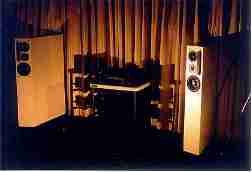 With
direct comparison walking back to the other room, it didn't. The singer didn't sound as
"clean" or "dry." I think that a lot of it stemmed from close miking a
woman in an acoustically live room, and playing the captured signal, which was not
representative of the entire soundfield, into an acoustically dead room, with two
speakers. Maybe it would have been better to use just one speaker and put it up off the
floor somewhat. Not bad though, and far from embarassing.
With
direct comparison walking back to the other room, it didn't. The singer didn't sound as
"clean" or "dry." I think that a lot of it stemmed from close miking a
woman in an acoustically live room, and playing the captured signal, which was not
representative of the entire soundfield, into an acoustically dead room, with two
speakers. Maybe it would have been better to use just one speaker and put it up off the
floor somewhat. Not bad though, and far from embarassing.Bryston made it into many rooms, usually those stressing solid value for the money, which follows their basic agenda. Sharing a room with PMC, they displayed some interesting new products. They had a five channel amplifier chassis which could accommodate up to five true monoblock modules added as per the discretion of the buyer. They also showed a single amplifier module meant to be attached to the speaker. Neat idea I think.
Camelot, with the help of Nordost Flatline cables and a TMS Adiabat speaker system w/ a 15" Isobaric subwoofer, put together a nice combo for the money, mated with a Lexicon amplifier (a Bryston design in disguise.) The ribbon tweeter, and what looked like a Dynaudio mid let the Camelot Uther processor deliver a very spacious and entirely enjoyable experience with the listening material I brought.
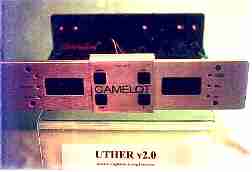 After I
toed in the speakers a few degrees, the sound actually got very respectable. Very good
depth and some nuance without the irritation one finds in many digital sources. I'd like
to try one at my house and see what it can really do.
After I
toed in the speakers a few degrees, the sound actually got very respectable. Very good
depth and some nuance without the irritation one finds in many digital sources. I'd like
to try one at my house and see what it can really do.Kingergetics' Chiro had some amazing slam for the clam with their home theater processors and amplifiers, as did B&K which hopefully can deliver their $2,500 receiver that includes both AC-3 and DTS, plus 105 watts all the way around. Value seemed the theme that week.
I got to hear Sennheiser's HD600s. Wow. Pretty nice for not much more than the acclaimed HD-580s. More open and dimensional, with even richer detail. The HD-580s did have a subtle buzz on the right side, but I don't think that accounted for the difference. They also came out with their own version of Dolby Pro Logic with headphones, based on preset Head Related Transfer Functions we learned about in aural perception class. Essentially, it takes a map of a generic head and processes the signal to imitate the effect of sounds coming from different directions. If you happen to have one of those heads, it works pretty well. Unfortunately, none of the presets kicked in with me when I tried the Auri wireless version which uses the same set of algorithms. Supposedly an AC-3 version with active head tracking to counteract the effect of a turning head is in the works. Wait and see I guess. Wait and listen is more like it.
The Wilson Audio/Krell/Levinson/Audio Research exhibit had a lot of physical presence. Spacious, larger than life, almost grotesquely visceral with lower frequency energy and resonance. The room itself couldn't begin to do the system justice. Standing waves, standing waves, standing waves. Most people around me appeared to be impressed by it. It seems common in designs utilizing a rear port. Topic for another article I guess.
I listened to the Von Schweikert VR-8s hooked up to $60,000 of BAT gear. I then went upstairs and listened to the VR-6s with the less expensive stuff and liked it more. The VR-8s, about fifteen feet from the rear wall and a foot and a half from untreated side walls, reminded me of the Wilson X-1 fighterplane-looking towers as far as bottom end punch and authority, but refused to lock down an image, instead spreading the sound all over. The VR-6s, although less impressive initially, actually eeked out some precision in a room full of curtains, and farther away from side walls, straddling a corner. They were a little too wide for the listening position, in my opinion. See what I mean about the importance of integration?
DTS demonstrated music mastered for surround sound. Much, much better than anything through a Pro Logic processor. It impressed me with the enveloping dimensionality, but still, I have my concerns. Another article later I suppose when there's time to get into it.
Lexicon (the professional presence) had their own processor which included algorithms used in their professional pieces, highly regarded by better engineers. Listened to a remastered Sting album lately? Like or dislike the music, the quality of the DSP reverb rules. They use the same technolgy in an ambiance extraction circuit which can "decode" unencoded source material into soundfields more natural than "Stadium."
These caught my attention, but there was so much there. I have to commend the show staff for putting together a relatively well-organized, and easy to navigate event. One could conceivably see everything worthwhile in a long day, or comfortably in two. It took me three just to make sure I saw it all. As for my votes for best of anything, I lost my ballot, but here goes:
Best sound (music) - go back to the beginning of this article, do not collect $200.
Best sound (video) - The DTS room with the Theta Casablanca, four Classe CA-400s, and a horde of Martin Logans beefed up by a Rel subwoofer.
Best picture - The Meridian Room, with Vidikron projector, Snell & Wilcox Interpolator, The Vidikron Projector with the Faroudja Line Quadrupler in the Cello room making a good run for it.
After the long weekend, tiring myself out shuffling around from room to room in an under-air-conditioned edifice, as fun as it was, I just want to sit at home and listen to some music. I hope that those of you who could make it enjoyed it also.
Colin Miller
John E. Johnson, Jr.
Although the Hi-Fi '97 Show was smaller than the hi-fi and home theater portion of CES, it gave us the chance to take our time and see everything. Having about ten exhibits on each of twelve floors of the Westin made the hallways less crowded, and provided for more exercise too. The weather was unusually warm for San Francisco at that time of year, and most of the rooms were rather steamy.
One exhibit (Ultimate Entertainment) combined a Vidikron front projector, Snell & Wilcox Interpolator, Stewart Screen, and Meridian 586 DVD player. When I walked into the room, I thought at first it was film. The Interpolator fills in between the scanning lines, but not in the same way that a line doubler or quadrupler does. Instead, the Interpolator decides on what scanning rate is best for the particular projector. The normal scanning rate for NTSC is 15.75 kHz. Line doubling provides 31.5 kHz, and quadrupling is 63 kHz. If the "Golden Scanning Rate" for a projector is 47 kHz, the Interpolator delivers it. The total cost of the system (projector, Interpolator, and screen) is about $80,000, but it is the best video image I have ever seen.
Paradigm showed some new home theater speakers that are all self powered. That is, the front left/right, center, and rear left/right, each has its own power amplifier on board.
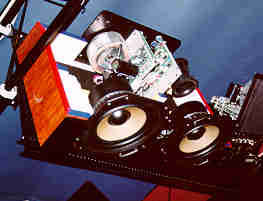 Actually,
there are multiple amps on board, one for the tweeter and one for the woofer. The
amplifier panel has controls to contour the output characteristics of each speaker. The
sound was fabulous, and this is a good example of what can be done when the amplifier is
designed specifically for the speaker it drives.
Actually,
there are multiple amps on board, one for the tweeter and one for the woofer. The
amplifier panel has controls to contour the output characteristics of each speaker. The
sound was fabulous, and this is a good example of what can be done when the amplifier is
designed specifically for the speaker it drives.Tubes are still in vogue, and Wavestream Kinetics was showing some big ones. Their Triode V8 Monoblocks, at $30,000/pair, deliver 300 watts rms per channel, and weigh 100 pounds each (the gold colored amps in the photo).
 The stereo version, at a mere $16,000 (the black one
in the photo) delivers 150 watts per channel. They were driving electrostatic speakers,
which is not an easy task for tube amplifiers.
The stereo version, at a mere $16,000 (the black one
in the photo) delivers 150 watts per channel. They were driving electrostatic speakers,
which is not an easy task for tube amplifiers.I walked into the Acoustic Research room, where a movie was playing. There was no audible harshness even though the sound was at high SPL. I calculated that, at that volume, they must be driving the speakers with at least 500 watt/channel monoblocks, as some exhibitors have done in the past. When the movie sample finished, I asked the exibitor what amp he was using. He said it was a Kenwood 5 channel home theater amp, at 135 watts/ channel, and it was not turned up very much. My eyes swiveled to the speakers.
 "Which speakers are those?" I
said. "The AR-312 HOs," he replied. "The sensitivity is 97 dB/w/m. That's
why we get such volume with not a lot of amplification." No kidding, I thought. And
great sound too. With a nominal impedance of 8 Ohms, just about any amplifier can raise
the roof. A 1" dome tweeter, two 5 1/4" mids, and a 12" side mounted woofer
are enclosed in this slim line floorstander. The price? $1,199/pair. For those of you who
have a surround sound receiver, these would make a dandy addition, since receivers don't
usually have very big amplifiers.
"Which speakers are those?" I
said. "The AR-312 HOs," he replied. "The sensitivity is 97 dB/w/m. That's
why we get such volume with not a lot of amplification." No kidding, I thought. And
great sound too. With a nominal impedance of 8 Ohms, just about any amplifier can raise
the roof. A 1" dome tweeter, two 5 1/4" mids, and a 12" side mounted woofer
are enclosed in this slim line floorstander. The price? $1,199/pair. For those of you who
have a surround sound receiver, these would make a dandy addition, since receivers don't
usually have very big amplifiers.One of the most beautiful product lines I saw was the Balanced Audio Technology array of tube preamplifiers. The VK-3i, at $1,995, and VK-5i, at $4,000, have a superb layout and are exquisitely crafted.
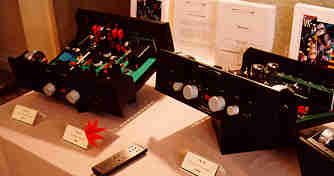 Their power amps are solid state, and use only two gain stages
(most amplifiers have at least three). The power amps appeared to be as well built as the
preamps, but it was those tubes that really caught my eye. The combination of tube
preamplification and MOSFET power amplifiers is a favorite of mine.
Their power amps are solid state, and use only two gain stages
(most amplifiers have at least three). The power amps appeared to be as well built as the
preamps, but it was those tubes that really caught my eye. The combination of tube
preamplification and MOSFET power amplifiers is a favorite of mine.Odyssey had an interesting twist. Their stereo preamplifier, stereo power amplifier, and pair of speakers, were each priced at $995. The power amplifier delivers 150 watts/ch into 8 Ohms.
 The products are all outsourced in the manufacturing to keep the cost low. The interesting
twist is that for an additional $125, you can get the amplifiers in designer colors, even
violet!
The products are all outsourced in the manufacturing to keep the cost low. The interesting
twist is that for an additional $125, you can get the amplifiers in designer colors, even
violet!Reference Line Audio showed their Model One Power Amplifier. It is rated at 100 watts of Pure Class A power per channel. Take a look at the power supply inside the chassis. Notice how it takes up most of the space.
 THAT is an indication of a good power amplifier. Ten MOSFETs per
channel are in the output stage of the Model One. The amp dissipates 600 watts of heat at
idle. Price - $6,000. It sounded like a lot more than 100 watts. Amazing dynamics. That is
a product of Class A operation and a massive power supply.
THAT is an indication of a good power amplifier. Ten MOSFETs per
channel are in the output stage of the Model One. The amp dissipates 600 watts of heat at
idle. Price - $6,000. It sounded like a lot more than 100 watts. Amazing dynamics. That is
a product of Class A operation and a massive power supply.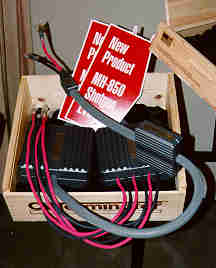 MIT had
their new MH-850 Shotgun Audio Cables on display. Not very spouse acceptable, and quite
expensive I'm sure (didn't have a chance to ask because the room was jammed with
visitors). But MIT is renown for quality, and I bet they sell a lot of these overseas.
MIT had
their new MH-850 Shotgun Audio Cables on display. Not very spouse acceptable, and quite
expensive I'm sure (didn't have a chance to ask because the room was jammed with
visitors). But MIT is renown for quality, and I bet they sell a lot of these overseas.John E. Johnson, Jr.
![]()
� Copyright 1997 Secrets of Home Theater & High Fidelity
Return to Table of Contents for this Issue.

